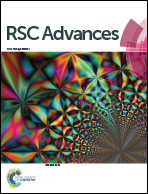Chemiluminescence determination of human serum albumin based on Co2+-catalyzed 2-(4-tert-butylphenyl)-4,5-di(2-furyl) imidazole/H2O2 system
Abstract
In this paper, the chemiluminescence (CL) reaction of 2-(4-tert-butylphenyl)-4,5-di(2-furyl) imidazole (t-BDFI) and H2O2 was investigated in alkaline medium. The H2O2 could directly oxidize t-BDFI to produce CL emission. The effects of some metal ions on CL of the t-BDFI/H2O2 system were examined. The results indicated that the addition of Co2+ into the t-BDFI/H2O2 CL system could induce significant enhancement of the CL signal. A CL system of t-BDFI/H2O2/Co2+ was developed. The experiment on the effect of human serum albumin (HSA) on the t-BDFI/H2O2/Co2+ CL system was carried out, and the result indicated that HSA could effectively inhibit the CL signal of this reaction. The inhibited CL intensity is linearly related to the logarithm of concentration of HSA. The linear range of the calibration curve is 5.0 × 10−8 to 1.0 × 10−6 mol L−1, and the corresponding detection limit (3σ) is 2.1 × 10−8 mol L−1. Based on this study, a novel CL method has been developed for the determination of HSA with high sensitivity and good selectivity. The proposed method has been successfully applied to the determination of HSA in human serum samples. This may intrigue researchers into gaining a new interest in investigating the CL property of heterocyclic imidazole derivatives.


 Please wait while we load your content...
Please wait while we load your content...